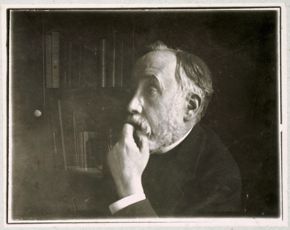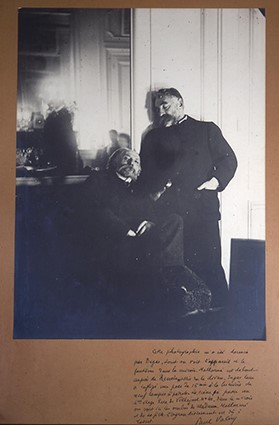Curator Malcolm Daniel Provides a Snapshot of Degas December 12, 2016

Edgar Degas, Self-portrait in Library, 1895, gelatin silver print, Musée d’Orsay, Paris, gift of the Société des Amis du Musée d’Orsay. © RMN-Grand Palais / Art Resource, NY
A view of the photographs on view in Degas: A New Vision.
Few people know that late in life, when his paintings and pastels were already famous, Edgar Degas briefly took up photography. Some 20 of his surviving photographs are featured in the exhibition Degas: A New Vision. Malcolm Daniel, the Gus and Lyndall Wortham Curator of Photography, spoke with me about Degas’s photography.
What was the psychological connection between events in Degas’s life and his decision to take up the camera?
In 1895, the year Degas took up photography with great passion and creativity, he was also burdened by feelings of mortality, and I think his photographs are closely linked to a deep melancholy, prompted by the illness and death of various friends and family members and by his own failing eyesight. The very act of photographing friends brought pleasure and distraction along with the challenge of exploring a new kind of picture-making.
Do you see aesthetic connections between Degas’s photographs and his work in other media?
The compositions and posing of figures in f his photographic portraits are close to what we find in some of his paintings, and the general sense of figures emerging out of darkness that we see in many of his photographs always reminds me of his slightly earlier “dark field” monotypes. More important is Degas’s willingness to break the accepted rules of photography and—as he did with paint and pastel and monotype—bend the medium to meet his own restless creativity.

Edgar Degas, Auguste Renoir and Stéphane Mallarmé, December 16, 1895, gelatin silver print, Bibliothèque littéraire Jacques Doucet, Paris. Image © Chancellerie des Universités de Paris - Bibliothèque littéraire Jacques Doucet, Paris
Describe Degas’s approach to photography.
Degas said “Daylight is too easy. What I want is the atmosphere of lamps and moonlight.” In the exhibition, visitors can see a portrait of artist Auguste Renoir with poet and critic Stéphane Mallarmé. Degas gave the photograph to his friend, the poet Paul Valéry, who wrote on the mount that the exposure, lit by nine oil lamps, lasted 15 minutes—probably an exaggeration, but far from the instantaneity that most turn-of-the-century photographers strove for.
Do you have a favorite work on view in Degas: A New Vision?
On the evening of December 28, 1895, Degas photographed friends at the home of his close friends Louise and Ludovic Halévy. Degas made a simple mistake failing to note which plate holders he had already used, accidentally double-exposing two negatives instead of properly exposing four. After discovering that kind of error once the plates were developed, most photographers would have discarded the results. Instead, Degas printed them and gave copies to Ludovic, who pasted two prints of the same image—one turned 90 degrees—in his family album. That page is displayed in the exhibition.

Edgar Degas, Mathilde and Jeanne Niaudet, Daniel Halévy, and Henriette Taschereau; Ludovic and Louise Élie Halévy, December 28, 1895, gelatin silver print, private collection.
See the selection of Degas’s photographs in “Degas: A New Vision,” on view in the Law Building through January 16.





